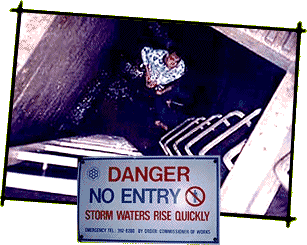
In one of the best lines in last summer's hit film The Blair Witch Project, a lost film student tries to cheer her colleagues, reminding them that the forest they are passing through will inevitably give way to a highway or subdivision. "After all, " she says, "this is America -- we've destroyed all our natural resources."
In an age of cell phones, GPS-devices, and sport utility vehicles, it's easy to buy into Heather's smug attitude. Four hundred years of systematic paving, plowing, and polluting have reduced the North American continent to little more than a giant theme park.
Or have they? For some explorers, our culture's legacy of ecological antipathy is bearing some interesting -- albeit chemically laced -- fruit. Urban rivers, dumps, and underground catacombs have become modern-day versions of the forest primeval -- perfect places for scaring the bejeezus out of our inner-Puritans while also offering moments of soul-testing solitude.
Diving Detroit
Rich Blumenfeld, a scuba diver who hails from the Detroit suburb of Roseville, Michigan, has a playful term to describe his near-daily romps in the St. Clair River, the international waterway linking Lake Huron to the north with Lake St. Clair and Lake Erie to the south.
"I call it 'freighter tag,'" says Blumenfeld with a dark chuckle. "You can always tell whether they're going upstream or downstream by the difference in sounds."
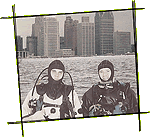 Overhead traffic is just one of the many hazards of scuba diving the Great Lakes and surrounding waterways. Blumenfeld recalls encounters with police, bacteria, diseased fish, and the occasional high-suction vortex created by uncharted municipal marine intake tubes.
Overhead traffic is just one of the many hazards of scuba diving the Great Lakes and surrounding waterways. Blumenfeld recalls encounters with police, bacteria, diseased fish, and the occasional high-suction vortex created by uncharted municipal marine intake tubes.
"I didn't know what it was until my mask started fluctuating wildly on my face," says Blumenfeld, recalling an intake tube incident. "Fortunately, I reacted quickly before it could suck my upper torso in." Despite such scary moments, Blumenfeld says rust-belt waterways offer a combination of fish and underwater artifacts unlike any other marine habitat in the world. Free to explore this habitat in near seclusion, Blumenfeld says the experience has opened his eyes to the evolving relationship between man and his underwater neighbors.
"One time, when a freighter came in overhead, I dove for cover beneath an old Chevy on the river bottom," he says. "When I got there, I found all the fish had beaten me to it. They were using it for shelter just like I was."
Blumenfeld says he logs more than 200 dives a year, mostly in the upper and lower St. Clair. Occasionally he'll go offshore diving near downtown Detroit, an activity he doesn't recommend to all divers.
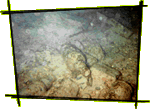 "If they catch you launching out of the city parks, they'll take your gear and your car," Blumenfeld warns. "That's why whenever I go diving down there, I usually wear an old suit and drive a beater car." Although pollution has decreased significantly in the Great Lakes and surrounding tributaries since the bad old days of the 1970s, Blumenfeld says scuba diving in the industrial Midwest is still not for the faint of heart.
"If they catch you launching out of the city parks, they'll take your gear and your car," Blumenfeld warns. "That's why whenever I go diving down there, I usually wear an old suit and drive a beater car." Although pollution has decreased significantly in the Great Lakes and surrounding tributaries since the bad old days of the 1970s, Blumenfeld says scuba diving in the industrial Midwest is still not for the faint of heart.
"My experience is the farther south you go, the more tumors you see on the bluegill," he says. "Up in Lake Superior, where the water is cleaner, you don't see any tumors on the fish. When you get to Lake Huron and the upper St. Clair [River], about one in 10 have tumors. In Lake Erie, it's even worse."
For humans, Blumenfeld says the primary concerns are bacteria and their attendant side effects: colds, fever, and inner ear infections. So far, Blumenfeld says he's managed to avoid these drawbacks by using a dry hood and by limiting his down-river dives to the winter and spring months when the water is cleaner.
Despite such limitations, Blumenfeld says the rivers and lakes in the Detroit metropolitan area offer a treasure trove of artifacts -- anchors, milk jugs, and even a few Prohibition-era whiskey bottles. "What's really impressive, though, are the guns," Blumenfeld says. "Near downtown Detroit, the whole bottom is littered with them."
Kayaking L.A.
Finding a small piece of solitude in a city of three million inhabitants is no easy task, but for Los Angeles resident Denis Schure, it's simply a matter of hoisting a canoe over his head, crossing the street, and dropping into the nearby Los Angeles River.
"Literally, in the heart of the city you can get on stretches of the river that are essentially unknown and invisible," says Schure. "We're talking green, attractive... teeming with wildlife. It's quite amazing and reassuring."
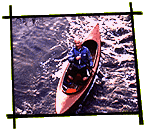 If, as Thoreau observed in Walden, "the life in us is like the water in the river," one hopes this doesn't apply to the Los Angeles River. An international symbol of a city that grew up too fast, the river has become a post-apocalyptic backdrop for graffiti artists and Hollywood chase scenes, all the while serving as a primary drainage channel for every toilet, factory, and storm drain east of the 405 Freeway.
If, as Thoreau observed in Walden, "the life in us is like the water in the river," one hopes this doesn't apply to the Los Angeles River. An international symbol of a city that grew up too fast, the river has become a post-apocalyptic backdrop for graffiti artists and Hollywood chase scenes, all the while serving as a primary drainage channel for every toilet, factory, and storm drain east of the 405 Freeway.
The effluent-dominated waterway is clean, by EPA standards. Still, occasional traces of lead, hepatitis, and E. coli keep the faint hearted away. As scary as it may be from a recreational perspective, however, Schure doesn't hesitate to throw in a few Thoreau-like descriptions of afternoons spent floating past cottonwood trees and the occasional rusty shopping cart. "There's something about... being on moving water," Schure says. "With the surrounding vegetation, it's physically and spiritually possible to leave the city at times."
 As a dedicated environmentalist, Schure has ulterior motives besides personal fulfillment. Most environmentalists have long viewed the Los Angeles River as a lost cause, but Schure is a leading member of an advocacy group, Friends of the Los Angeles River. He sees his solo kayaking efforts as a way to motivate other residents into looking at the river in a new light.
As a dedicated environmentalist, Schure has ulterior motives besides personal fulfillment. Most environmentalists have long viewed the Los Angeles River as a lost cause, but Schure is a leading member of an advocacy group, Friends of the Los Angeles River. He sees his solo kayaking efforts as a way to motivate other residents into looking at the river in a new light.
"I usually view the Los Angeles River as a worst-case scenario," Schure says. "Just think of what recreational opportunities would be available with just a little concerted effort."
Schure is sensitive to the risks of pioneering, however. Officially, the entire Los Angeles River is one giant no-trespassing zone according to both the city and the Army Corps of Engineers, the government agency currently charged with overseeing its 22-mile waterway. Schure has spent the last decade getting friendly with the various permitting agencies and avoiding run-ins with the law.
He has also become more cognizant of personal safety in recent years. News reports on surfing-related illnesses stemming from the elevated bacteria counts have prompted him to be more careful in navigating the more polluted lower stretches of the river near Long Beach. "I've been physically immersed in that water for 10 years and have not had any physical effects to show for it," he says. "At the same time, I'm less willing to get wet than I used to be."
Tunneling Toronto
While many toxic explorers provide a modern day twist on the age old back-to-nature impulse, 20-something Toronto native "Ninjalicious" offers a less romantic attitude:
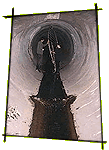 "I have no idea why people get so excited about nature," writes Ninjalicious -- an explorer whose many spelunking adventures within the sewer lines and storm drains of Toronto provide the primary material for the Infiltration.org Web site. "I find trees and grass very boring and vastly prefer the possibilities offered by concrete and steel." Spurred on by the Internet, the sport of "draining" -- also called "vadding" or "sewering" -- is by far the most popular form of toxic adventure. The Yahoo Recreation/Hobbies/Urban Exploration page lists more than 25 sites, most of which have a subterranean theme.
"I have no idea why people get so excited about nature," writes Ninjalicious -- an explorer whose many spelunking adventures within the sewer lines and storm drains of Toronto provide the primary material for the Infiltration.org Web site. "I find trees and grass very boring and vastly prefer the possibilities offered by concrete and steel." Spurred on by the Internet, the sport of "draining" -- also called "vadding" or "sewering" -- is by far the most popular form of toxic adventure. The Yahoo Recreation/Hobbies/Urban Exploration page lists more than 25 sites, most of which have a subterranean theme.
"If you've explored one forest you've pretty much explored them all," he says. "Generally speaking, forests and other natural areas have far less historical significance and relevance to our daily lives than manmade structures."
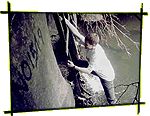 Ninj says he prepares for most tunneling escapades by putting on work clothes, boots, and bringing along a flashlight, pen and pad, camera, and a "couple of drinks" as accessories. So far, his activities have taken him to almost every corner of the Toronto netherworld. "I once took a large-scale map of the city and shaded in every location I'd explored and the downtown core was quite thoroughly inked up," he writes. "Toronto's suburbs house a few treasures, and suburbs are always a good place to look for easily-accessible storm drains. In addition to Toronto and its surrounding suburbs, Ninj says he has explored the nether reaches of more than a half-dozen cities, stretching from Rome to Los Angeles.
Ninj says he prepares for most tunneling escapades by putting on work clothes, boots, and bringing along a flashlight, pen and pad, camera, and a "couple of drinks" as accessories. So far, his activities have taken him to almost every corner of the Toronto netherworld. "I once took a large-scale map of the city and shaded in every location I'd explored and the downtown core was quite thoroughly inked up," he writes. "Toronto's suburbs house a few treasures, and suburbs are always a good place to look for easily-accessible storm drains. In addition to Toronto and its surrounding suburbs, Ninj says he has explored the nether reaches of more than a half-dozen cities, stretching from Rome to Los Angeles.
As the world becomes an increasingly toxic environment, these trailblazers may come to be seen as the founding fathers of an entirely new genre of sports. Of course, they could just be fools speeding towards a cancerous oblivion. But if you're going to be exposed to toxins anyway, adventuring sure beats the hell out of cigarettes.
Sam Williams is a freelance writer living in Oakland, California. His favorite environmental pollutants are benzene, selenium, and polychlorinated biphenyls.
